The largest black hole in a known part of the universe
- Transfer
Human experience shows that one cannot quickly come into the light. It is necessary to go through twilight on the emerging day before noon and the sun floods the landscape.
- Woodrow Wilson
We know how the majority of black holes are formed in the Universe: after the death of massive stars (from 20 solar masses or more), black holes with a mass of three solar ones appear. Such stars burn the fuel contained in the core faster than others - in just a few million years - and when the core can no longer burn, they collapse. And nothing inside the stars, neither atoms, nor nuclei, nor quarks with gluons, can resist the gravitational collapse if there was enough mass in the star!
When a star reaches a mass of 100 solar, very strange things begin to happen in its bowels. In particular, the inner core of the star heats up so much that a noticeable part of the photons reaches an energy exceeding 511 KeV, an important energy threshold. It is large enough for two colliding photons to spontaneously generate an electron-positron pair!
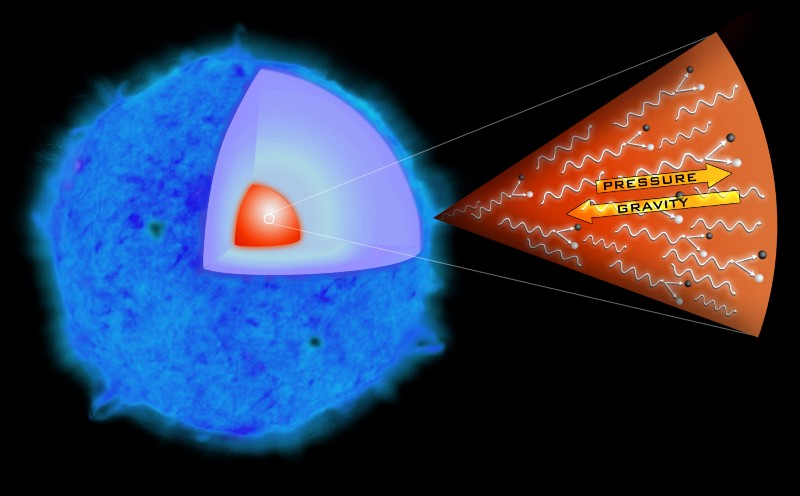
In a regular star, outward pressure and gravitational inward compression are balanced and hold the star. But this pressure turns out to be photons moving at the speed of light, and if these photons suddenly turn into slowly moving particles of matter and antimatter, the pressure will drop, and possibly critically.
Depending on the mass of the star, all of it can experience a synthesis reaction that gets out of control, destroying the entire star, or, for the most massive stars, most of this mass can collapse into a black hole! This is exactly what we expect from a large number of stars in the nearest star cluster: R136 in the Tarantula Nebula.
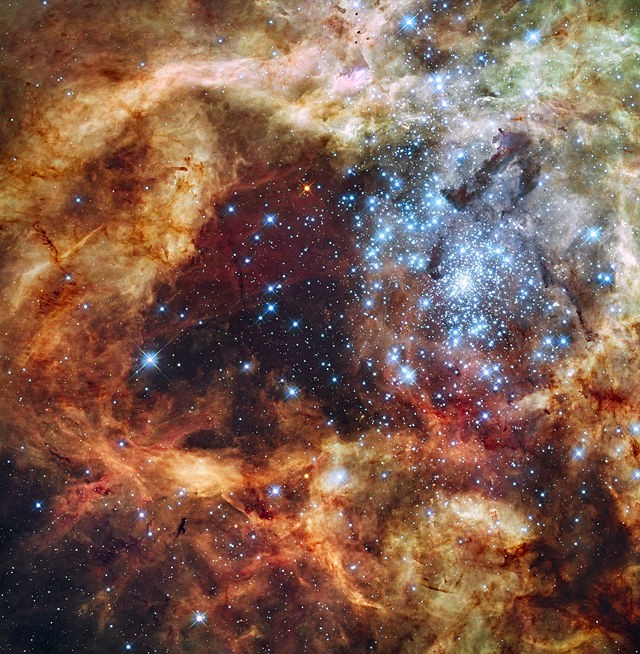
The universe has been around for many years, and it has had many opportunities to create large, supermassive stars that have lived, died and turned into black holes. In the center of galaxies, in particular, these black holes have the opportunity to merge and grow strongly. Over time, supermassive black holes appear in most galaxies - our galaxy, containing a black hole weighing four million solar, will not be an exception. It can be measured almost directly by observing the rotation of known stars around a point that does not emit light. Moreover, for the existence of these orbits, a mass of 4,000,000 solar is required.

We must remember that in our galaxy there are from 200 to 400 billion stars, so the mass of our black hole is about 0.1% of the total mass of the galaxy. This is a small part, but a big number. Now imagine that our galaxy is not among the large ones, and our black hole is at the end of the supermassive list.
There are huge galactic monsters and the largest of the closest to us will be Messier 87, a giant galaxy in the center of the Virgo cluster.
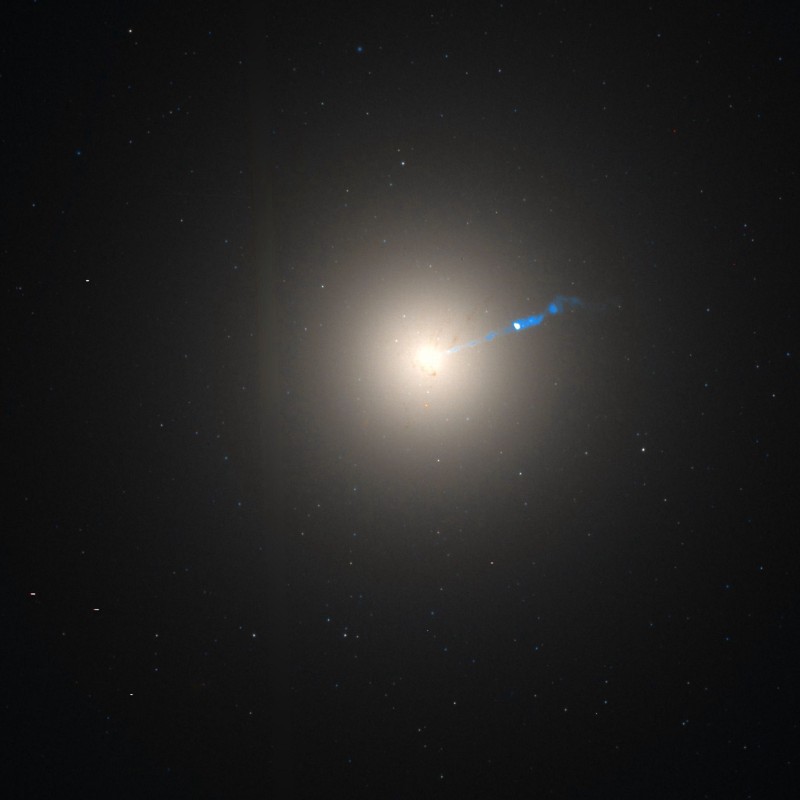
This is the largest of the nearest galaxies, with a mass exceeding 200 times our mass. It may seem strange to you the “line” emerging from it. As far as we know, this is a relativistic stream of matter 5,000 light-years long, emanating from the center of the galaxy! The only object known to us that is capable of producing such a phenomenon is a supermassive black hole, significantly larger in size than the one located in the center of our galaxy.
If we need to measure the mass of this black hole, it is better to turn to x-ray images of the Chandra space telescope.
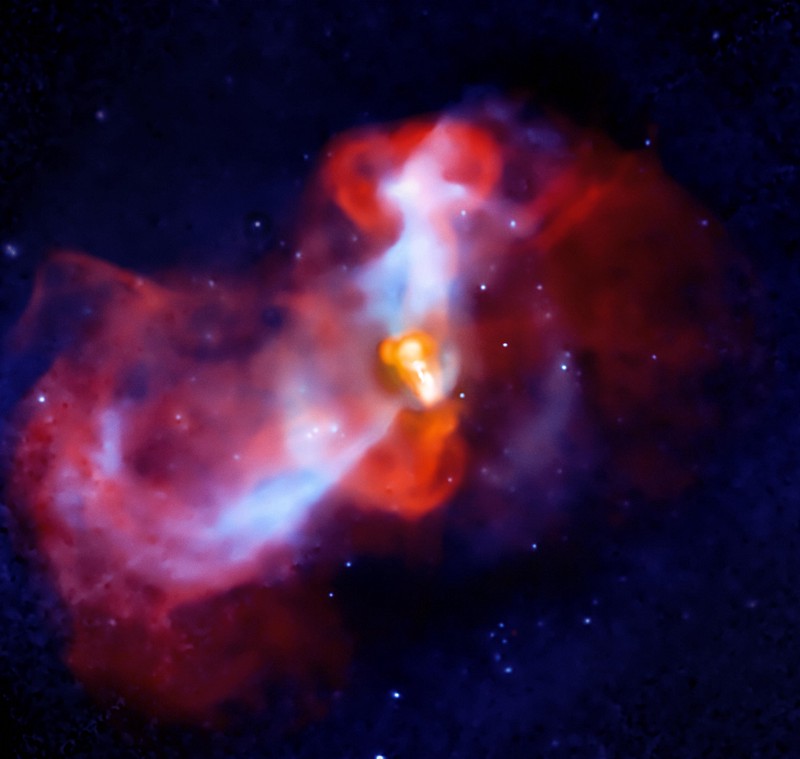
The most recent measurements show that there is a supermassive black hole in the galaxy with a mass of 6.6 billion solar cells - an amazing number, 1,500 times larger than the mass of a giant in the center of our galaxy! This can be confirmed by radio-frequency jet measurements carried out on the VLA.
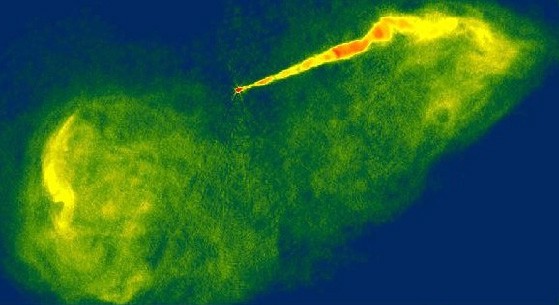
Interestingly (to me), the previous estimate of the mass of the central black hole came from measuring flares in the center of M87, which gave a mass of 6.4 billion solar. In other words, we are well versed in what is happening there!
But until you decide that Messier 87 is some kind of abnormal anomaly, let me show you most of the Virgo cluster.
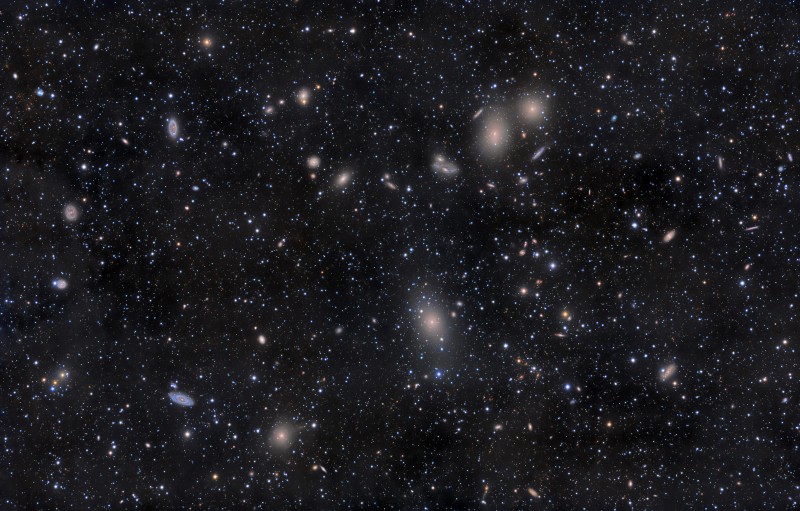
In addition to M87, there are other giant elliptical galaxies at about the same distance, including M84, M49 and M60, each of which has a black hole weighing more than a million solar. It is believed that usually - although there are options - elliptical and lenticular galaxies are formed through the merger of several spiral ones, their central black holes also merge, and therefore about 0.1% of the total mass of the galaxy is contained in a central black hole.
Therefore, we can assume that in search of the largest black hole, it is necessary to study the largest galaxies. Let's try!
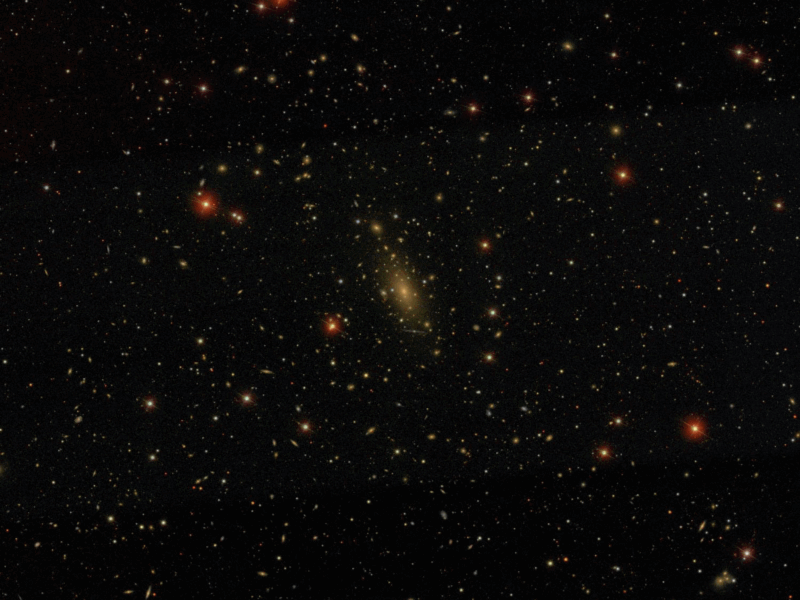
This is the Abell 2029 cluster, located at a distance of 1.07 billion light-years, or 20 times farther than the Virgo cluster. At its center is the largest of all known galaxies of the Universe: IC 1101. The galaxy in the most elongated direction extends over two million light years, surpassing Messier 87 many times, and has the largest of the known galactic masses in the Universe. It extends a distance two times the distance from the Milky Way to Andromeda! Including dark matter, its mass is equal to 100 trillion solar, or about the entire total mass of the Virgo cluster. (If you google the images of this galaxy, you can stumble upon too exaggerated images. Be careful).
What about her black hole?
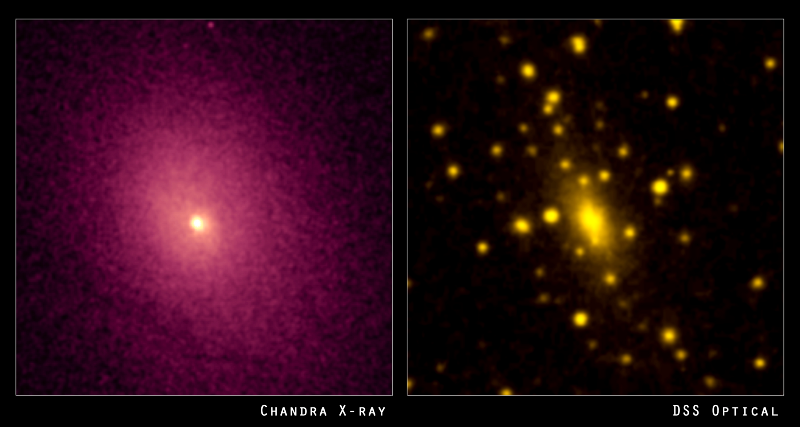
If we knew ... It is too far from us, not active enough, and our current space devices do not have sufficient accuracy to measure its parameters. Maybe one day! And if I bet, I would be ready to bet that it really contains the largest black hole in the known Universe.
It would be a smart bet, but I would not be surprised if I made a mistake, and the reason for the possible mistake will surprise you!
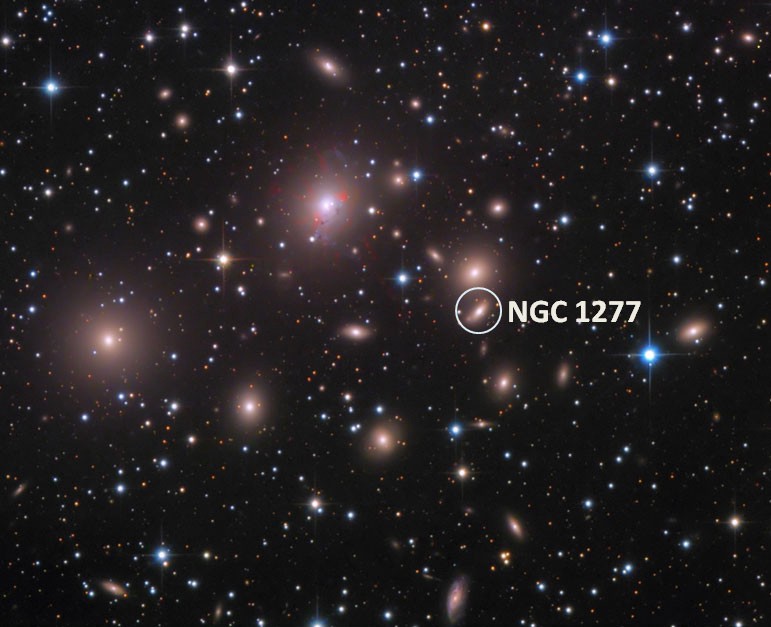
This is the Perseus cluster, a less impressive cluster than Abell 2029. The large active galaxy in its center is amazing, and the highlighted galaxy is completely nondescript: NGC 1277. This cluster is relatively close to us, just over 200 million light-years away, and the distance to NGC 1277 is very typical, about 220 million light years. This is not the largest galaxy, not the most elliptical, not the most massive, not the brightest. In general, judging by its stars and a total mass of 120 billion solar, it is even less massive than the Milky Way!
But if you observe the gas in its center (and it is located close enough to us to detect it), you can see how it moves and measure its kinematics. The faster the speed increases as you approach the center, the better you can estimate the central mass of the galaxy.

This galaxy should have a central black hole with an amazing mass of 17 billion solar, making up an amazing 14% of the total mass of the galaxy! This is an unprecedented number, and it is not only the most massive black hole we have found, but also the largest percentage of the ratio of the mass of the black hole to the galaxy. There are other cases with fairly high percentages - NGC 4486B and Henize 2-10 - but these galaxies are smaller.
Therefore, of course, it is possible that the largest black hole is contained in the largest galaxy in the Universe, but it is also possible that the record holder will be an unremarkable lenticular galaxy, which, for some reason we do not yet understand, contains a huge black hole!
On the other hand - within the error of our measurements - there is another candidate for the largest black hole in the known Universe, very different from the NGC 1277 considered by us.

See the point indicated in the figure? This is the OJ 287 galaxy, belonging to a special class of objects called blazars. These are compact extragalactic sources of radio waves, and one of the most energetically powerful objects in the Universe. This is a special type of quasar - an active galaxy - in which one of the most powerful relativistic jets is directed in our direction!
Recall how objects such as these active galaxies work: their supermassive black holes feed on stars, gas, and other space objects. Since they break structures with the help of gravity and greatly accelerate them, the eaters from them are sloppy. And although this is one of the main ways of growing black holes, it is also one of the ways the Universe tells us about their presence!
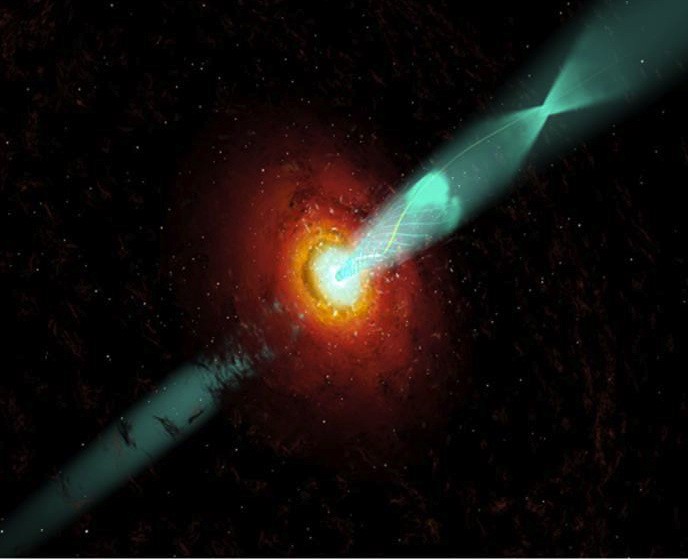
The brightness of this source periodically changes - with a period of 11-12 years - and it emits flashes in a narrow double burst associated with maximum brightness. It looks beautiful in radio waves and in x-ray radiation, and the observations coincide not only with the fact that there is a supermassive black hole of huge sizes, but also with the fact that smaller supermassive black holes move around it in orbits.
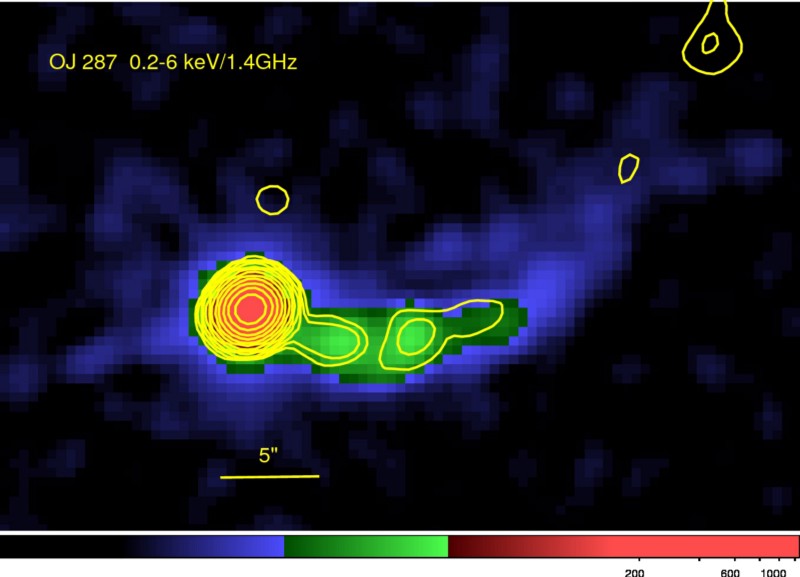
This galaxy is located about 3.5 billion light-years from us, and contains perhaps the largest known black hole weighing 18 billion solar. (But due to measurement errors, the results strongly overlap with NGC 1277). The most amazing attraction of this galaxy - and the reason that we can study its central region - is a black hole with 100 million solar masses (25 times more massive than a black hole in the center of the Milky Way), orbiting an even larger black hole!

A system with an orbit 300 times larger than the orbit of Pluto around the Sun, making a revolution in just 12 years, will allow us - if we calculate everything correctly - to conduct the greatest test of the general theory of relativity. While the precession of Mercury's elliptical orbit around the Sun is 43 "in a hundred years due to relativistic effects (1 ° equals 3600"), this smaller black hole should have a 39 ° precession in one revolution and should fall in a spiral into a big black hole in just a few thousand years!
And these two galaxies, the nearest and shallow NGC 1277 and the very distant OJ 287 contain the largest of the known black holes in the Universe. Of course, there are black holes and larger ones, but to find them, we need more luck, time and better radio telescopes and X-ray equipment.
